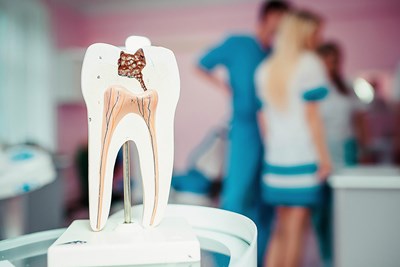Periodontitis (also known as periodontal disease) is a bacterial infection of your gums that is often the result of bad oral hygiene. If left untreated, the disease can result in tooth and bone loss. Here is a comprehensive overview of this common gum disease, including symptoms, causes, diagnosis, and treatment.
Symptoms
If your have periodontitis, your gums may look swollen, bright red or purplish. They will also feel tender or sensitive to cold. The infection can also cause your gums to recede. Additionally, you may find that the disease creates new spaces between your teeth, pus between your teeth, bad breath, a bad taste in your mouth, or loose teeth.
You should schedule an appointment with your dentist at the first sign of periodontitis symptoms.
Causes
Gum disease is caused primarily by bad oral hygiene. Plaque is removed from your teeth when your brush and floss regularly. If you do not have good oral hygiene, plaque can harden into tartar under your gum line. Damage to your gums, bone, and teeth can occur if plaque and tartar remain on your teeth.
Risk Factors
The following factors increase your risk of developing periodontal disease:
- Tobacco use
- Being over the age of 65
- Family history of periodontitis
- Poor nutrition
- Obesity
- Stress
- Medications that cause dry mouth
- Grinding/clenching your teeth
Diagnosis
Diagnosing periodontitis involves a mouth exam. Your dentist will look for plaque and tartar buildup and to see if your gums bleed easily.
To determine the severity of your periodontitis, your dentist will use a dental instrument to measure the depth of the groove between your teeth and your gums—this area is known as a periodontal pocket. Your dentist will also take x-rays to check for bone loss in areas where deeper pocket depths have been observed.
Treatment
Treatment for periodontitis focuses on cleaning the pockets around the teeth and preventing damage to surrounding bone. If your infection is not advanced, you may be treated with a procedure known as scaling and root planing. This deep cleaning removes tartar and bacteria from your tooth surfaces and under your gums. In order to completely eliminate the bacterial infection, you may be prescribed antibiotics in the form of oral antibiotics or a mouthwash. In addition to these treatments, you will need to practice good oral hygiene.
If your periodontitis is advanced, you will need a surgical procedure to treat the infection. Depending on your situation, there are a few different types of dental surgeries that may be useful:
- Flap surgery (pocket reduction surgery): This involves lifting back your gum tissue for more effective scaling and root planing.
- Soft tissue graft: If you have a receding gum line, you will need a soft tissue graft, which replaces lost or damaged gum tissue with a sample of tissue taken from the roof of your mouth or a sample from a donor source..
- Bone regrowth procedures: If your gum disease has caused bone damage or loss, you can benefit from bone grafting, guided tissue regeneration, or enamel matrix derivative application. All three procedures stimulate bone regrowth.



